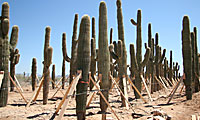Enjoy the view - trees and cacti replanted to maintain the scenery on Loop 303
Enjoy the view - trees and cacti replanted to maintain the scenery on Loop 303

Who says constructing a freeway through a beautiful desert expanse has to spoil the view?
Once the new stretch of Loop 303 opens this month, motorists will see for themselves that great care was taken by ADOT and its project partners to keep the scene as pristine and seemingly untouched as possible.
Native desert plants that lived in the path of the new freeway were not just pulled up and thrown away – they were uprooted, cared for during freeway construction and then replanted alongside the new road.
Crews began by taking an inventory of all the plants surrounding the 14-mile stretch of highway. There were saguaros, barrel cacti, several other cactus varieties, ocotillo, mesquite, ironwood and palo verde trees to contend with.
Landscapers decided which plants to salvage based on a variety of factors, including the plant’s species, size, health and aesthetic qualities. The saguaros and some of the other cacti are designated by law as protected, which means they cannot be allowed to succumb to construction projects.
A total of about 6,900 cacti and nearly 1,000 trees were tagged, dug up in such a way to preserve their roots and carefully replanted in three nurseries located on the construction site – the nearby location was good for the plants because they were already used to the site’s soil conditions.
Special care was taken to help keep the plants comfortable in their new, temporary home. Gravity-fed water systems were set up in the nurseries to ensure the plants thrived.
To assist in the transition back to their permanent spots along the 303, contractors saved the top layer of native soil from the roadbed and applied it to the slopes where a majority of the replanting occurred.
The forethought paid off...so far, there has been a 90 percent survival rate for all the plants.
Outside contractors will care for the plants for the next two years. During that time, there also will be a temporary watering system in place alongside the freeway.
After the two years are up, the irrigation system will be taken out and the plants should be ready to make it on their own. The cost savings associated with this project include not having to install granite mulch, new plants and underground irrigation pipes and controls.
ADOT’s Chief Landscape Architect LeRoy Brady says he’d like to issue a challenge to people to watch as the vegetation stabilizes and adds to the area aesthetically.
He says that in addition to the replanting, all medians and roadsides have been hydro-seeded with 20 different species of plants – that means the area will continue to change, develop and grow more beautiful over time!

